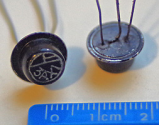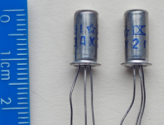You are using an out of date browser. It may not display this or other websites correctly.
You should upgrade or use an alternative browser.
You should upgrade or use an alternative browser.
Chinese semiconductor industry
- Thread starter Hendrik_2000
- Start date
- Status
- Not open for further replies.
Perhabs @WTAN could add more information about this?According to 02 project outline,28nm lithography machine is suppose to be pass the acceptance exam by 2021. But it is Nov already, and there is still no announcement from SMEE,so people suspect that the project has failed.
I'm pretty sure US has sanctions against Russia on lithography tools. It's part of Wassenaar Agreement. It's just that no one is talking about it since Russia is so far behind in IC.Yea, but the thing is the US has no lithography machine sanctions on Russia, but has them on China. The speaker (Ma) has clearly stated that China needs to incentivise domestic industries (say through subsidies) to use 90nm chips (and design their products around such outdated chips) for now (as much as this would be a temporary setback for the smartphone and PC industry) before the SMEE's 28nm and 14nm lithography machines are ready. While such strategy would set the Chinese electronics industry 10 years behind the West and South Korea, at least China could begin the process of achieving 100% self sufficiency.
Ultimately, China is going to be 2-3 generations behind TSMC and South Korea regarding chips' nm counts for the foreseeable future, but there are ways to design final products (like cellphones, computers, AI tools, weapons, etc.) around such bottleneck.
Just curious, could chip (processors in general) be one of the reasons why Chinese and Russian solid-fuel SAMs (and some other guided weapons) tend to have bigger size but shorter range compared to their most recent American counterparts? Just asking.
Also, what you are stating is basically suicide for Chinese OEMs like BBK, Xiaomi, Lenovo, etc. What China could do is incentivize companies that use >28nm chips (ie. automotive, home appliances, industrial equipment etc.) to use domestically made chips. I'm sure there are a lot of them.
I'm pretty sure US has sanctions against Russia on lithography tools. It's part of Wassenaar Agreement. It's just that no one is talking about it since Russia is so far behind in IC.
Also, what you are stating is basically suicide for Chinese OEMs like BBK, Xiaomi, Lenovo, etc. What China could do is incentivize companies that use >28nm chips (ie. automotive, home appliances, industrial equipment etc.) to use domestically made chips. I'm sure there are a lot of them.
This is about the elbrus line from Russia. I believe they are on a 28 nm node.
Yes, but if China designs a photonic chip that is several times more powerful than a traditional chip, it won't matter if China's lithography technology is up to snuff. The performance advantage of the photonic chip can make up for it, just like a better software algorithm can compensate for a slower CPU. As long as China's photonic technology is further along than the West, it can potentially catch up to the West in actual processing performance without needing to do so on traditional semiconductor manufacturing.I am not saying photonic chips are useless but thus far they are only usable in niche applications. They simply aren't required in nearly the same amounts. Plus saying "photonic chips" only describes how they work, but a lot of photonics chips types are made with the same lithography tools as standard chips. Because those are what's available to make small detailed features on the cheap en masse.
I am more and more convinced that there is hope for China after all, but it relies on China investing now on leapfrog technologies like Quantum computing or photonic chips. After all, EUV lithography itself was a leapfrog technology over DUV. It was highly theoretical and didn't work for 20 years. The West pursued it in no small degree because they realized they couldn't beat the Japanese at DUV lithography. And indeed, it wasn't until EUV came out that Nikon was finally kicked out of the leading edge lithography node. The West invested in a leapfrog technology (EUV) and kept at it despite many failures. And it paid off in spades.
Further, it is easier for China to surpass the West in new technologies than in complex, mature technologies. For instance, Huawei already did 5G which surpassed the West, that is why Huawei was targeted to begin with. That is because during that time (the 2000s and early 2010s) telecom technology was still immature, and it was easy for Huawei to become the most advanced in the world. If Huawei had tried to replicate traditional semiconductors and their entire supply chain, it would never have developed 5G. Photonic chips and quantum computing is more akin to 5G, and less akin to traditional lithography.
Think of it this way.
The West was already doing lithography at the 28nm node ten years ago. If China invested tremendously in traditional lithography for the next ten years, where do you think they would be in 10 years from now? If you are optimistic, then they would have reached the 5nm, 3nm or 2nm nodes, roughly similar to where the West is today. But by then the West would have moved on with another ten years of development. Even the most optimistic people here say that China only needs "good enough" chips for most needs and don't claim China can surpass the West.
However, China's latest Quantum computer released this year is already several times faster than the Sycamore processor that Google released in 2019. In other words, while China is 10+ years behind the West in traditional semiconductors, it is less than 2 years behind the West in quantum computing (and possibly even ahead of the West). If China were to invest tremendously in quantum computers for the next ten years, where do you think they would be in 10 years? Would they be ahead of where the West is today? It's a virtual certainty. China has a far, far, far, far, far better chance at surpassing the West by investing in new technology like photonic chips and quantum computing than investing in traditional semiconductors. All I am saying is China should focus on where its relative strengths lay, and for China that is in new leapfrog technologies. Is it a risk? Yes. Given how badly China is lagging behind, is it a risk worth taking? Absolutely.
Nothing to get too concerned about this.Perhabs @WTAN could add more information about this?
They have obviously set a high benchmark for the SMEE 28NM DUVL which is the ASML 2000i.
This is the first advanced DUVL from SMEE so it may not have entirely matched the specifications of the 2000i.
I have always mentioned from the start that the SMEE DUVL is equivalent to the 1980i.
This means that the SMEE DUVL should be good for 28nm and 14nm IC fabrication. SMIC uses the 1980i for its N+1 process.
Also the Certification process for Mechanical Equipment in China is extremely rigorous.
An example is the certification process for the civilian airliners like Arj 21 and C919.
The Equipment is put through a great amount of testing during the acceptance test which can cause delays.
But i expect everything to go according to plan and for the SMEE 28nm DUVL to be used for 14nm and 28nm IC Production starting in 2022.
@WTAN Sir I'm waiting for your respond cause your opinion carries weight, just as what @tokenanalyst had posted 2 generation behind ASML (NXT 2000i and 2050i) but share the same basis and foundation for future improvement, that for me is the most important thing. We had achieved a technical breakthrough with full spectrum indigenous development breaking the western monopoly. Sir another thing from what I gather SSA800 SMEE DULV had been certified and that is why it's puzzling after reading the article.Nothing to get too concerned about this.
They have obviously set a high benchmark for the SMEE 28NM DUVL which is the ASML 2000i.
This is the first advanced DUVL from SMEE so it may not have entirely matched the specifications of the 2000i.
I have always mentioned from the start that the SMEE DUVL is equivalent to the 1980i.
This means that the SMEE DUVL should be good for 28nm and 14nm IC fabrication. SMIC uses the 1980i for its N+1 process.
Also the Certification process for Mechanical Equipment in China is extremely rigorous.
An example is the certification process for the civilian airliners like Arj 21 and C919.
The Equipment is put through a great amount of testing during the acceptance test which can cause delays.
But i expect everything to go according to plan and for the SMEE 28nm DUVL to be used for 14nm and 28nm IC Production starting in 2022.
What qualifies you to have any "thoughts" about this subject, especially something as specific as a timeline and how much that timeline is conditioned on espionage?I dont think China can build this even 10 years or more without espionage.
build a space station, can't build this? Go away sleepystudent.This is how EUV looks like. This machine is gigantic and very sophisticated machine. I dont think China can build this even 10 years or more without espionage.
View attachment 79152
- Status
- Not open for further replies.





